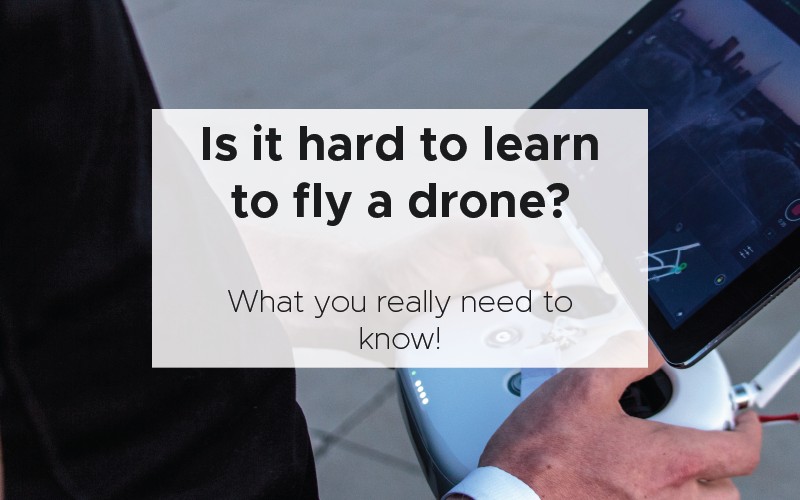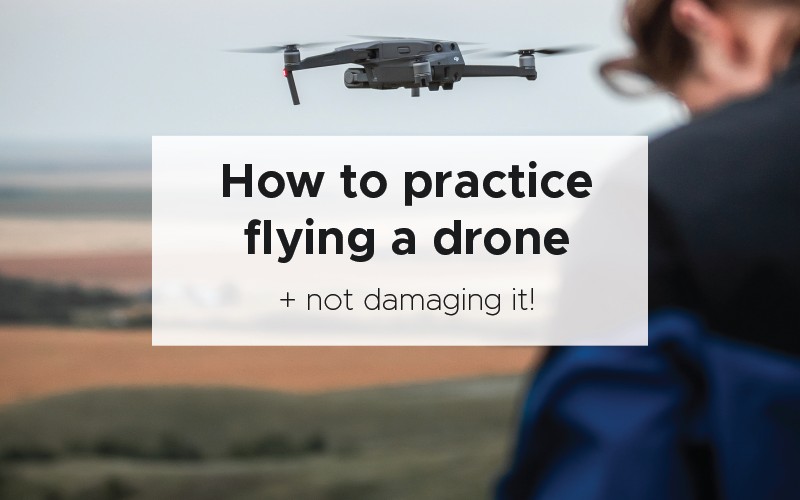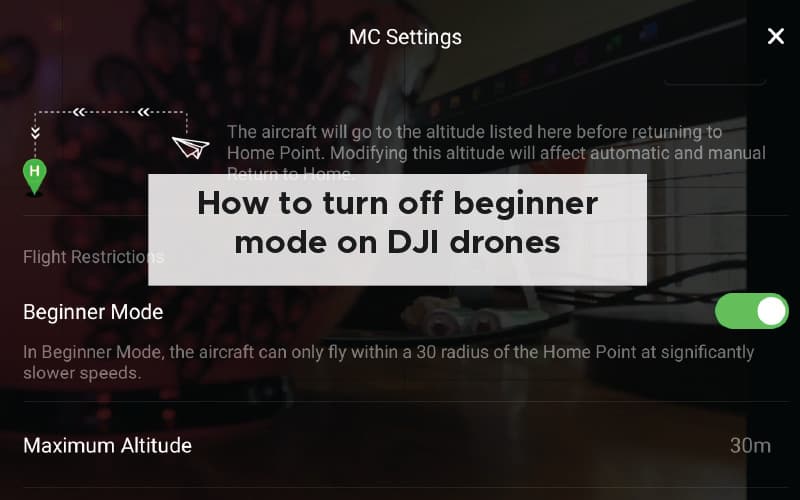Drone manufacturers want you to be able to enjoy your drone as quickly as possible. Drones are becoming easier to fly and, with advances in automated flying technology, drones are getting quicker to fly like a professional.
Depending on the skills, experience, and drone you have purchased, some drone students are ready to fly within minutes of receiving their drone. Other people require many hours of practice with a professional instructor to get everything just right.
In my experience, I was able to fly my DJI Mavic air within minutes of receiving the drone. The user interface of consumer-level camera drones has been perfected to become more and more intuitive to fly. I bought my first drone from an online marketplace, and I was lucky enough to have the previous owner take me through the drone’s most important controls and parts.
| Camera drone | 5 Hours |
| FPV racing drone | 500 Hours + |
| Commercial drone pilot | 100 Hours |
After a quick flight with the previous owner, I quickly went to a cricket oval where I flew my drone for about half an hour. At the end of the flight, I was slowly getting comfortable with the joystick control and the camera functions, but I had a lot of practice before getting the best shots and video possible from my drone.
Flying a drone is relatively simple. It is the things around the camera’s operation and collecting the highest quality footage, which requires practice. A drone pilot has to do many things at once to operate like a professional. Learning about flying, camera work, framing and getting the joystick controls feeling second nature takes a lot of time to practice.
This article will go over everything you need to know about how long it takes to learn to fly a drone and what you can do to speed up.
It depends on the type of drone
How long it takes to fly a drone depends on the type of drone you want to fly. Some new pilots are ready to fly within minutes, whilst others require many hours of practice. Some even require individual tuition from a professional instructor to bring all of the skills together.
Camera drone
If you have purchased a camera drone, you will likely be able to fly very quickly. Consumer-level camera drones have a very high level of automation and software designed to keep you safe in the air. They also have several sensors pointing in different directions to be your “eyes in the sky”. The sensors will ensure that you do not get close to anything that could clip your propellers and cause you to fall out of the sky.
With a camera drone – flying is easy; the artistic components of the camera work may take a lifetime to perfect.
Commercial license
Suppose you want to obtain a commercial license for flying a drone. In that case, you will require approximately 30 hours of theory and a minimum of five hours of practical instruction with a trained instruction pilot. As drone laws and regulations catch up with drone technology, legislators are creating more and more red tape and loopholes for you to jump through. Your local area likely has some specific requirements for piloting a drone which it is your responsibility to understand and make sure that you are flying illegally at all times.
Racing drones
A racing drone is even harder to fly since you rely on the first-person view, and it is likely to have zero flight automation. The drone may even lack simple stabilisation software such as GPS and auto-hover. This lack of automation and specific software combined with how fast the drone flies makes it very complicated and has a steep learning curve.
Racing drones also have a high level of customisation possible which means that you can easily have your controls set far too sensitive or your rate of acceleration set too high. It may take a while to grasp the fine controls of flying a racing drone – you have to make sure that you have the budget for a simulation package or replacement parts upon the inevitable crash landing.
Changing the rates by approximately 30% (the column labelled RC rates in the software) except for throttle can help.
If you are flying a racing drone, it could take 6 to 8 months before flying without seriously damaging your drone. Crashing is certainly part of the learning curve. Once your skills improve, your confidence will rise, and you will start feeling much better about your skills.
Some professionals recommend flying the same drone with the same settings all the time until you hone your first-person view or racing drone skills. You should purchase a cheap drone to practice with. The cheap drone means you won’t have to worry about crashing an expensive one. Once you get better, you can then switch over to your good drones, and it won’t hurt your wallet nearly as bad.
Other drone pilots say that if you are not crashing, you are not learning quickly enough. Burn through as many batteries as possible as quickly as possible to accelerate your learning and skills.
If you want to know more about how hard it is to learn to fly a drone check out my other article, where I go through everything you need to know about learning. Click here to be taken to the article.
How long does it take to learn to fly a drone really well?
Learning to fly a drone really well depends on the sort of level you want to reach.
Learning to fly a drone really well means that you are familiar with every single function of the drone software. You can overcome any issues such as flyaways, going out of range, and environmental hazards that pop up.
Camera drone
Learning to fly a camera drone well is surprisingly easy due to the automated flight features such as auto stabilisation, auto hover, GPS location mapping and artificial intelligence. It is the extra skills with a camera drone that require a ton of practice and artistic persistence.
If you want to learn to fly a camera drone well, you should learn about professional photography and honing your skills.
There are plenty of online photography courses which can streamline and accelerate your learning. Piloting the drone professionally and understanding exactly what the camera of your drone is doing will turn you from a hobby drone pilot to a professional very quickly.
It will take approximately six months to one year to get experience in various locations with your camera drone. Building a portfolio of awesome shots and videos will be the one thing that can attract clients quickly.
Racing drone
Learning to drive a first-person view or racing drone well takes much more skill. It can take many years to perfect your skills from the moment you first try racing until you are a professional drone pilot.
It may take up to 2 years of regular flying before you can fully understand how the drone reacts and fly a variety of different drones under different conditions.
Keeping on learning and not being put off by the challenges you face is the number one skill that you need to perfect if you want to fly a drone like a professional. Some days you will be disappointed with your progress, and other days you will be very happy. Practising no matter what will be the key to turning your hobby into something you are proud to show off.
Now, let’s have a quick look at how you can get better faster.
How to get better faster
Knowing exactly how you can practice is the number one way to learn to fly a drone quicker. If you want to know more about practising flying a drone check out my other article – click here. I go through everything you need to know in extreme detail to become a professional drone pilot quicker.
Utilise beginner mode
When you first get your drone, you may be very keen to fly fast and far away.
Most commercial level drones have a setting which is called beginner mode.
Drone manufacturers are well aware that the excitement of purchasing a drone means that many people will take it out of the box and fly within a matter of minutes – as long as the battery is charged.
Beginner mode limits the potential for a new pilot to damage the drone or other people by putting restrictions on flight limits and available features. They limit things like top speed, distance able to fly away from the remote controller, whether or not you have got GPS lock, and change your controller sensitivity so that large movements result in smaller actions from the drone.
Using beginner mode when you first get your drone can feel like a little bit of a waste of time. Still, it allows you to get used to the drone’s features slowly whilst avoiding overwhelm from the full suite of software and artificial intelligence flying features.
Get a load of hours under your belt
There is no substitute for practice. Getting out of your house and flying your drone as often as possible in the early stages will accelerate your learning quicker than anything else.
I highly recommend buying a second or third battery for your drone so that you can maximise your flight mission and flying time.
Every time I took out my drone in the early days, I would use all of the drone power possible for practising my manoeuvres and collecting the best shots I could from my camera.
Having extra batteries also means not worrying about wasting time with settings and other controller issues. Sometimes I would hover for an entire battery is worth it to go through certain aspects of the software and control system.
![How long does it take to learn to fly a drone? [Pro tips]](jpg/drone-1024x940.jpg)
Practise flying manually
Drone pilots can very often rely on all of the fancy software. To become a better pilot, I recommend that you practice flying without these fancy features. That is because if any of them fail, you will have the skills and confidence to bring your drone back to the landing point safely.
Consider turning off the GPS and compass as well as any other auto-hover features. Only do this in areas with wide-open spaces and do not start from too far away.
Practise around other pilots
learning to fly around other pilots is a great way to accelerate your learning. A simple conversation with a pilot who has been through all of the learning you are about to go through enables you to shortcut some of the more frustrating parts of flying a drone.
Check out your local drone flying community groups to enter a world of drone enthusiasts where I almost guarantee, that you will find new friends with a love of your nearest hobby.
Use a simulator
Sometimes, you can’t get out of the house to practice flying your drone. And that is okay. Life gets in the way of a load of things, including the best laid down plans to practice your drone flying skills.
It could be the weather; it could be personal; whatever it is, you can use a drone flight simulator to practice your drone skills. The good thing about this approach is that you can be boisterous and daring because nothing will get damaged if you crash a virtual drone. Unlike in real life, many hundreds of dollars (if not thousands of dollars) could be lost with a simple lapse in concentration.
Here are the top flight simulators you can buy (the DJI simulator even has a free option).
- DJI Drone Simulator – Free, Enterprise, and Energy versions available. It has different training modules that support nearly every drone that they have manufactured.
- DroneSimPro – $29.99 for Mac and Windows.
- Real Flight RF8 – $188 for windows
- Phoenix R/C – $139 for windows
The great thing about the DJI drone simulator is that your remote control for your drone plugs into your computer via the USB port, and it is exactly like controlling your DJI drone in real life.
Do some (online) courses
There are a few places where you can find information and help from pilots that have been through it all.
Many universities and adult education institutions are now offering short courses so that you can become accredited in your country. Even if you do not require to become accredited for flying a drone in your country, it is still a very good idea to invest the time and money into learning from a professional.
It will catalyse your improvement and stop you from making silly mistakes that many of us make and are too stubborn to realise.
If you are interested in an online course, here are some examples of drone schools and courses that may interest you:
- Drone U – drone new offers some of the widest range of drone training courses, from beginner to advanced training. This course is a subscription model, and they currently charge a $470 per year membership, or you can pay $47 per month. This price gets you a private Facebook community, access to all online training courses, as well as a bunch of other resources.
- Drone Launch Academy – this is an online course that is based primarily on video content. It primarily has content about part 107, and the cause can be purchased for $149.
- Drone pilot ground school – this company has trained 25,000+ solo pilots and enterprise drone, pilot teams. Depending on how many people in your team need to get their part 107 certification, the cost varies from $299 for one person to $192 per person for 10 to 24 people.
- Drone training on Udemy – If you’re looking for specific drone skills, a well-received course is drone training: 50 drills to improve your flying skills. This course will learn about 50 drills to fly your drone with more precision and skill. The great thing is that it’s only about US$10 on sale. It has 3.5 hours of OnDemand video, two downloadable resources, and full lifetime access, as well as a certificate of completion once you are done.
There is no excuse not to consider getting help from a professional. Some of these courses are incredibly cost-effective, and I have seen first-hand the results of investing in my skill acquisition from a professional.
Summary
Ultimately, how long it takes to fly a drone depends on various factors, but within approximately six months of buying your drone, you will be able to fly until it becomes second nature. Manipulating a drone in 3D space can be very confusing, and you will need to practice until the drone does exactly what you wanted to do instinctively.
All movements such as pitch, yaw, thrust, role, and attitude can be combined in a range of different ways and can get very confusing quickly.
My last bit of advice for you is that you don’t practice until you get it right you practice in till you can’t get it wrong.
No matter how long it takes you, pushing through barriers and confusion and moments of frustration will be the one thing that will continually improve your drone piloting skills. Burning through as many batteries as possible in a short period will enable you to fly with confidence faster.
Good luck and enjoy the process!
![How long does it take to learn to fly a drone? [Pro tips]](jpg/how-long-does-it-take-to-learn-to-fly-a-drone-768x480.jpg)






